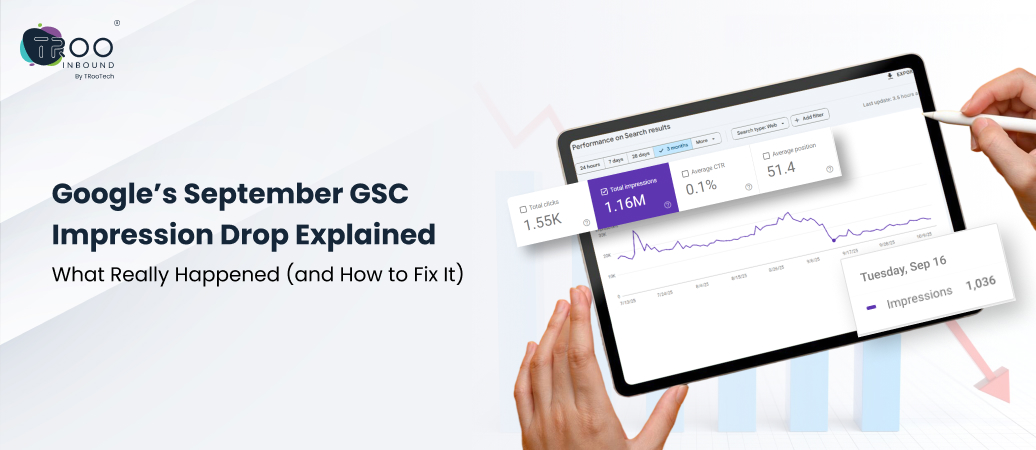Didn’t Discover!!
What You're Looking For?
Didn’t Discover!!
What You're Looking For?
Home Digital Marketing Google’s September GSC Impression Drop Explained: What Really Happened (and How to Fix It)

 By
Aman Bhati
By
Aman Bhati
Did you notice a sudden, massive drop in your Google Search Console (GSC) impressions recently? Don’t worry, you aren’t alone!
According to an SEO expert, Tyler Gargula, almost 87.7% of sites experienced drops in impressions in mid-September 2025 after Google disabled the &num=100 parameter and made other significant changes.
But here’s the reality: many of those drops are likely not caused by lost rankings, algorithmic penalties, or sudden demand shifts. Instead, they look like measurement shifts, data cleanup, and structural changes in how Google reports visibility.
This blog specifically focuses on the explicit reasons behind this sudden fall and what measures you can take to regain impressions on your content. Let’s dive in to explore everything in detail.
In mid-September 2025, a quiet but seismic shift unfolded. If your impressions suddenly dropped, there’s a high chance you were hit by what many in the SEO world are calling the num=100 change.
What changed?
What difference does it make?
For some, it also caused an increase in average position
In short
Even if &num=100 is the big recent shake, here are some possibilities of why GSC impressions may fall:
1. Google’s Algorithmic Updates
Google regularly updates its ranking algorithms and how it evaluates content, relevance, freshness, E-A-T, etc. A core update or relevance rebalancing can shift which pages get surfaced more often.
If your content is seen as less relevant, outdated, or inferior to competitors, you may lose impressions.
2. Indexing / Crawling Issues
Pages dropping out of the index due to robots.txt, noindex tags, sitemap changes, or errors will lose impressions.
3. Search Intent Shifts & Query Trends
User behaviour evolves. A topic may wane in popularity, or search phrasing may change. If many of your high-impression queries fall out of favour or the query landscape shifts, you lose impressions even if you rank well.
4. Technical SEO problems
Server downtime, broken canonical tags, redirect chains, or changes in URL structure can block Google from accessing pages.
5. Increased Competition/ Query Cannibalisation
New competitors or content changes could push your pages down. Or you may be unintentionally competing with your own pages.
6. Manual Penalties or Spam Filters
Less common but critical: if your site triggers a penalty or gets flagged for policy violations, pages may be suppressed. You’ll often see notifications in GSC.
7. Content Quality / Relevancy Decay
Maybe competitors have produced fresher, more authoritative versions on the same topic. If Google deems your content to have a lower value, it may reduce how often it surfaces.
GSC’s impression drop may have multiple factors working behind the scenes. If you tangled here, hire an SEO expert and let them help you get your impressions back on track.
Now comes the detective work. Use the data in GSC and external tools to triangulate the cause. Here’s a step-by-step approach you can use to find the root cause:
Step 1: Look for the infection point
Step 2: Check whether the drop is site-wide or in segments
Step 3: Cross-check on Google Analytics (GA4)
Step 4: Inspect Indexing Section
Step 5: Check for External Shifts
Step 6: Look for penalty signals
Step 7: Crawl & technical audit
Once you gather evidence, you can narrow it down to whether this is a measurement change (num=100) or a real visibility issue. Then you can apply the appropriate fixes.
Once you find the root cause, here are tactics you can use to recover and stabilize:
Over time, you should see impressions and rankings climb back for high-value pages if your fixes are well aligned.
This shift strongly suggests that SEO experts think out of the box to keep up with modern ways of ranking your content.
If your Google Search Console impressions have recently dropped, it doesn’t necessarily mean your SEO efforts are failing. For instance, the recent num=100 change has altered how impressions are counted, causing many websites to appear as though they’ve lost visibility even when rankings and traffic remain stable.
Instead of reacting in panic, you need to respond with analysis. The key solution here is to diagnose before reacting and to interpret metrics through the right lens. For that, you can monitor your data, compare timeframes, review indexing and technical performance, and evaluate whether this drop truly reflects a loss of visibility or just a reporting adjustment.
At TRooInbound, we help businesses approach moments like this with clarity and strategy. Our approach focuses on connecting data signals across GSC, Analytics, and keyword trends to identify what’s really changing and what actions will make the biggest impact. If you ever need expert help decoding those shifts, TRooInbound is always ready to guide you with data-driven insight and proven SEO expertise.

Dive into other interesting, well-researched, and nicely structured blog posts
 a CTA
a CTAWe will strategize our execution based on your requirement
Stay up to date by subscribing to our newsletter.
5900 Balcones Drive STE 100, Austin, TX 78731
Velocity 904-910, L.P. Savani Road, Nr. Madhuvan Circle, Surat, Gujarat 395009
5900 Balcones Drive STE 100, Austin, TX 78731

Call
+91 27174 54342

Email Address
hello@trooinbound.com

Skype Id
nikhil.jani

Schedule A Meeting
meeting/nikhil-jani
Copyright © 2025, TRooInbound. All Rights Reserved.